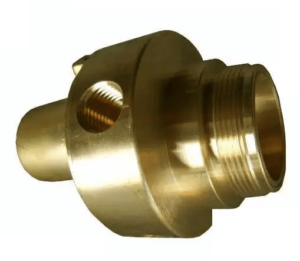Copper casting is a process used to create intricate metal parts. It involves melting copper and pouring it into a mold to create a specific shape. Copper casting has been used for centuries to create a wide range of objects, from decorative art pieces to functional tools and machinery parts.
One of the main benefits of copper casting is its versatility. Copper is a highly malleable metal, which means it can be easily shaped and molded into a variety of forms. This makes it an ideal material for creating custom parts and components that are tailored to specific needs. Copper casting is also a cost-effective way to produce large quantities of parts, as the molds can be reused multiple times. Additionally, copper is a durable metal that can withstand high temperatures, making it suitable for use in a variety of industries, including aerospace, automotive, and electronics.
Benefits of Copper Casting
High Thermal Conductivity
Copper is known for its high thermal conductivity, which means it can transfer heat quickly and efficiently. Copper casting is an excellent choice for applications that require heat dissipation, such as electrical components and heat exchangers. Copper’s ability to conduct heat also makes it a popular choice for cookware and other kitchen appliances.
Excellent Corrosion Resistance
Copper has excellent corrosion resistance, which means it can withstand exposure to moisture and other corrosive elements. This makes it a popular choice for marine applications, as well as plumbing and HVAC systems. Copper casting is also an excellent choice for outdoor applications, as it can withstand exposure to the elements without rusting or corroding.
Superior Strength and Durability
Copper is a strong and durable material that can withstand heavy use and wear. Copper casting is an excellent choice for applications that require strength and durability, such as automotive and aerospace components. Copper is also resistant to fatigue, which means it can withstand repeated stress without cracking or breaking.
Overall, copper casting offers a range of benefits that make it an excellent choice for a variety of applications. Its high thermal conductivity, excellent corrosion resistance, and superior strength and durability make it a popular choice for a wide range of industries.
Copper Casting Process
Pattern Making
The first step in copper casting is pattern making. This process involves creating a model of the desired object, typically out of wood or plastic. The pattern is then used to create a mold for the final casting.
Mold Making
The next step is mold making. The pattern is placed in a container and surrounded by a molding material, such as sand or plaster. The mold is then allowed to harden and the pattern is removed, leaving a cavity in the mold that is the exact shape of the desired object.
Melting and Pouring
Once the mold is complete, the copper is melted in a furnace and poured into the mold. The temperature and pour rate are carefully controlled to ensure the copper fills the mold completely and evenly.
Cooling and Solidification
After the copper has been poured, it begins to cool and solidify. The cooling rate is carefully controlled to prevent defects in the final casting, such as shrinkage or cracking.
Finishing and Inspection
Once the copper has cooled, the mold is broken apart and the casting is removed. The final step is finishing and inspection. The casting is cleaned up and any rough edges or imperfections are removed. The casting is then inspected for quality and any defects are repaired.
Overall, the copper casting process is a complex and precise process that requires skill and attention to detail. By following these steps, high-quality copper castings can be produced for a variety of applications.
Applications of Copper Casting
Automotive Industry
Copper casting is an essential process for the automotive industry. It is used to create various parts such as engine blocks, transmission components, and brake calipers. The high thermal conductivity and corrosion resistance of copper make it an ideal material for these applications. Additionally, copper’s ability to withstand high temperatures and pressures makes it a suitable material for use in engines and transmissions.
Electrical Industry
Copper casting is also widely used in the electrical industry. Copper is an excellent conductor of electricity, and its casting process allows for the creation of complex shapes and designs. Copper is used to create electrical connectors, motors, and transformers. Its high conductivity and low resistance make it an ideal material for these applications.
Construction Industry
In the construction industry, copper casting is used to create various architectural elements such as door handles, light fixtures, and decorative elements. Copper’s malleability and ductility make it easy to cast into intricate designs. Additionally, copper’s ability to resist corrosion and weathering makes it a popular material for outdoor applications.
Marine Industry
The marine industry also relies on copper casting for various applications. Copper’s corrosion resistance makes it an ideal material for use in marine environments. Copper is used to create propellers, valves, and other critical components in ships and boats. Additionally, copper’s antimicrobial properties make it a popular material for use in water filtration systems on boats and ships.
In conclusion, copper casting is an essential process used in various industries. Its unique properties make it an ideal material for use in automotive, electrical, construction, and marine applications.

Mechanical / Structure Parts One-Stop Manufacturer
CNC machining / Mold-Tooling / Metal Parts / Plastic Parts / Assembly
Many designer and start up company have amazing ideas and new products includes plastics, metals, electronics components and so
on. But how to find a professional and reliable manufacturer to help them make their ideas come true? You might be one of them?
DGHY Tmetal is a good choice for you!
We offer not only custom parts service, tool & die mold design and manufacturing, casting and injection molding production, sheet
metal fabrication, but also offer final product assembly service. We can help your project from prototyping, trial run, to final
smooth mass production. OEM, ODM both are welcome.
DGHY quite understand prototyping phase is very important for you to find out where the designs’ problem is, our engineering
technical team will give strong support from design improving to process improving, until get your prototype done perfect.
For custom parts manufacturing, generally, we make prototype by CNC machining in our CNC Machine shop.
For trial run, if quantity not large, CNC machining still is a better way to choose.
Mass production will need open Die mold(Tooling), this way production capacity will increase a lot, product cost will get much
cheaper and quality will be more stable as well.
Hengke Metal offer you one-stop manufacturing solution, we have our own Mold Tooling workshop, CNC machining shop, die casting shop,
plastic injection shop and sheet metal fabrication shop, this enable us could help you saving your project management cost and
time, and make your products to be more competitive in the market!
Item | die casting service | |||
Material | Aluminum alloy: ADC12, ADC10, A360, A380, A356, 6061, 6063 | |||
Magnesium alloy: AZ91D, AM60B | ||||
Zinc alloy: ZA3#,ZA5#,ZA8# | ||||
Processing Craft | Drawings→ mould making → die casting →degating and deburring → CNC machining→surface treatment →product checking→ packing→delivery | |||
Tolerance | ± 0.01mm | |||
Surface treatment | Electroplating, Electrophoresis, Anodization, Polishing, Sandblasting, Passivation, Powder coating, Spray painting, Etc. | |||
Quality Assurance | ISO9001:2015 Certified, Third party testing. | |||
Inspection | 1.Foundry in-house: 100% inspection on critical dimension; 100% on appearance. | |||
2.Third Party inspection available upon requirement. | ||||
Mainly Testing Facility | Three-dimensional measuring instrument (CMM), Salt spray test box, Dynamic balance detector, Pneumatic detection | |||
Lead time | Mould: 15~25 days; Sample: 3-5 day; Production: 10-15 days. | |||
Drawing format | .pdf / .dwg / .igs / .stp / x_t. (Provide by customer, or design according as the sample) | |||
Packing | Eco-friendly pp bag / EPE Foam /Carton boxes or wooden boxes As customer’s specific requirements | |||
Shipping way | Express /Air freight /Sea freight | |||
Trade terms | EXW / FOB / CIF | |||
